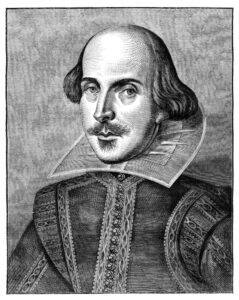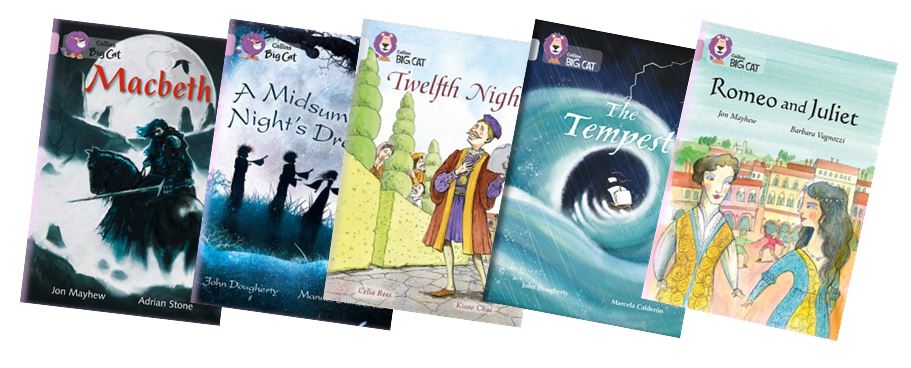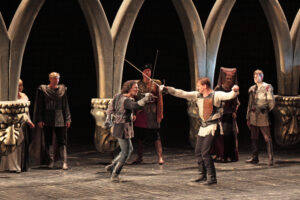Shakespeare, arguably the world’s greatest playwright and poet, died 400 years ago. A literary genius to most, a fraud to some, the enduring appeal of his plays to old and young cannot be over emphasised. For years, Shakespeare and his work were seen as the domain of older, studious people but the realisation that Shakespeare gave so much to the English language in terms of vocabulary, humour, tragedy and history persuaded publishers and educationists to bring Shakespeare to a younger audience.

The result at Collins are five plays: The Tempest, Midsummer’s Night Dream, Romeo and Juliet, Macbeth and Twelfth Night, rewritten in story form for younger readers. These are a great introduction to the world of Shakespeare but how can we use them effectively to help pupils immerse themselves in the rich language of Shakespeare’s world?
Activity One – Story to Play – Suitable for Years 3 to 6
Learning Objectives:
- To be able to recognise and use the conventions of play scripts
- To be able to able to write a play script from a narrative
Shakespeare’s plays are often long and complex – hence the reason why they have been rewritten by publishers in everyday language in narrative format to make them more child friendly. Opinion says that Shakespeare’s plays were written to be performed and not simply read. Collins Big Cat Shakespeare gives us the perfect material to be able to present Shakespeare as it was meant to be – in performance.
Ask the pupils if they can tell you the difference between a story and a play. Use the accompanying narrative and play script to illustrate. Suggest the following questions to guide them to their answers…
- How is the spoken work represented in each?
- How is action represented?
- How is the setting described?
- Why are there differences?
Now ask them to read the opening page of the Collins Big Cat version of A Midsummer’s Night Dream and model writing it in play format.
Choose a page from A Midsummer’s Night Dream which has plenty of dialogue and ask the pupils to rewrite it as a play script. Asking pairs or groups to take a page each and write it as a script will enable you to convert the whole book into a play script in no time, ready for the next activity.
Activity Two – Performance
Suitable for Years 3 to 6
Learning Objective:
- To be able to understand how Shakespeare’s plays were performed in terms of staging, costume and actors
- To perform a Shakespeare play to an audience
The play script you will have completed for the first activity is perfect for performance at an assembly and you can go authentic here by staging the play as it would have been in Shakespeare’s time. Then, the stage would have been a circular one with the audience all around it. Try to arrange your stage like this too. In Shakespeare’s time the actors would all have been men and the women would have been played by teenagers. Whilst it would be unfair to do this, it is worth explaining this to the pupils and asking them why they think this was the case.
Acting the play out on a central stage means that the actors will have to move more to be able to engage all of their audience. This helps pupils interested in drama to practise how they interact with an audience and works on the typical young actor’s problem of turning their back to an audience. Shakespeare’s plays would have had little in the way of scenery, the audience being expected to use their imagination. How can the actors make the audience believe a setting that they can’t see? To help them understand how this was done, let them listen to the words of the ‘chorus’ in Henry V here.
Activity Three – Extended Performance
Suitable for Years 3 to 6
Learning Objective:
- To be able to recite Shakespeare from a script or from memory
- To be able to use different voices to add meaning to a recital of part of a script
Shakespeare is said to be for performance and not for reading. Few people sit down to read Shakespeare’s plays but many will go to watch one, act in one or watch a TV or film adaptation of one.
Some years back, the BBC held a competition called ‘Off by Heart’ in which students were encouraged to take popular monologues from Shakespeare plays and practise them for performance in the competition.
Whilst originally aimed at secondary school students, the exercise is a good one to do with Key Stage 2 children and, despite the competition no longer running, the texts and notes on how they should be performed are still available for free on the BBC website.
Many of the scripts are well known and relatively easy and would make great Speaking and Listening exercises in drama.
Activity Four – Same Story, Different Setting
Suitable for Years 3 to 6
Learning Objective:
- To be able rewrite a story or play in a different setting to which it was originally set
- To be able to identify and use writing techniques to convey stories in different genres
To help bring fresh audiences to love Shakespeare and his language, many of his plays have been rewritten in different settings. Romeo and Juliet with Leonardo di Caprio is set in modern day Verona, Much Ado About Nothing was recently set in modern day California with the characters recast as FBI and criminals, whilst The Taming of the Shrew was recast in a high school setting in 10 Things I Hate About You.
In this activity, choose one of the Collins Big Cat Shakespeare stories and together with the pupils, pull out the structure of the story, almost like doing the plan for the story after it’s been written. From this, the pupils should be able to see how the setting and the characters can be transposed into a different setting and a different time. Macbeth is a great one to work from as the story is simple and the relationship between the characters and their ultimate destinies is easy to understand.
As a suggestion, the pupils could recast Macbeth in a school with the character from the title cast as a pupil who is controlled by a bully (Lady Macbeth) into doing things they shouldn’t do and whose actions lead them to feel guilty. Unable to undo what they have already done, they continue to do bad things until they are caught and punished by the headmaster (Macduff). Thereafter the good pupils take charge (Malcolm).
You could now ask them to consider different scenarios for a rewritten version of Macbeth or choose one of the other Collins Big Cat Shakespeare books for inspiration.
Collins Big Cat Shakespeare is a new Collins Big Cat Curriculum Collection. Collins Big Cat Curriculum Collections are packed with fiction and non-fiction books that match the programmes of study for English, Science, History and Geography. Find out more and order here.





